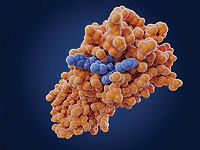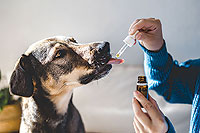Enzymes are tiny protein molecules found in every living cell that provoke chemical reactions in the body. The two main types of enzymes most important to your pet’s well-being are metabolic and digestive enzymes. There are also enzymes found outside the body in living, unprocessed whole foods.

Metabolic enzymes function throughout your pet’s body to help carry out the critical bodily functions of building and maintaining every cell, tissue, and organ. Enzymes are crucial to countless important bodily functions, as they act as catalysts for all cellular functions, including energy production and detoxification. Metabolic enzymes partly rely on specific vitamins and minerals to do their job, so nutritional deficiencies can disrupt a variety of bodily processes, such as impairing organ function over time.
The pancreas also makes enzymes specifically for digesting and assimilating nutrients, and these are what we’re focusing on today, because digestive issues are so common in pets. Three types of digestive enzymes work in the small intestine to break down the food your pet eats. These include:
· Protease (including trypsin) for breaking down protein into amino acids
· Amylase for breaking down carbohydrates
· Lipase for digesting fats
Dogs and cats produce these digestive enzymes naturally; however, for a variety of reasons they often don’t produce enough to process their food completely and efficiently.
How Your Pet’s Digestion Should Work
When dogs and cats consume a meal the stomach stretches, prompting a substance called gastrin to be released, which in turn prompts special cells in the stomach to release hydrochloric acid. The enzyme pepsin is also released, and mixes with the food as a “pre-digestive” step to help facilitate the initial breakdown of proteins. The food then moves into the small intestine, where the pancreas releases the digestive enzymes amylase, lipase, and protease. The gallbladder also secretes bile to help break down fat and stimulate peristalsis, among other important tasks.
When this process is working as intended, there’s a rich blend of gastric acids, digestive enzymes, and bile in your pet’s small intestine to facilitate optimal digestion and absorption of nutrients. However, if there’s dysbiosis or microbiome imbalance, and/or an insufficient supply of acids, enzymes, or bile, maldigestion and malabsorption of food can occur. In some cases, genetics can also play a role in heritable enzyme insufficiencies, such as exocrine pancreatic insufficiency (EPI). Unfortunately, this is a common issue among today’s canine and feline family members.
Why Your Pet May Lack Crucial Digestive Enzymes
Enzymes come from two sources — your pet’s body makes some of its own, and the rest come from the diet. Every raw, fresh food contains enzymes. Enzymatic activity is what’s responsible for fresh food spoiling; the enzymes go to work fast breaking down the fats, proteins, and sugars in the food.

However, enzymes are fragile and easily destroyed by heat and other types of food processing, as well as pesticides, herbicides, food preservatives, additives, and a host of other internal and external influences.
If your pet consumes a mostly ultraprocessed or cooked diet, they likely receive little or no enzymes from that food (as enzyme activity would greatly shorten the food’s shelf life) so must rely on the body to manufacture many or all the enzymes needed. The pancreas produces protease, amylase, and lipase, but often not enough to completely digest the food they eats.
In the wild, dogs and cats upcycle the pre-digested contents of the digestive tract of prey animals, as well as the pancreas, which are teeming with the beneficial digestive enzymes their bodies need. Because they receive sufficient enzymes from their prey for digestion, their own metabolic and digestive processes are not taxed. Both wild dogs and cats have also been documented to forage on grasses and other vegetation, which also supplements their bodies with addition food-based enzymes.
Even after thousands of years of selective breeding, not much has changed with your pet’s digestive system. Your dog or cat is still a carnivore with a body designed to eat a fresh raw meat-based diet, complete with supplemental pancreas tissue. Meat-eating animals naturally produce more protease to handle their high protein requirements, but they don’t produce much amylase because their ancestral diet doesn’t consist of grains nor do their bodies have a nutritional need for starches that require amylase for digestion. Today’s commercial ultra processed pet foods are intentionally enzyme-deficient to extend shelf life, not to mention the production of both canned food and kibble requires very high temperatures, which destroy any live enzymes present in the food. Raw and freeze-dried pet foods have the potential to contain some viable enzymes, because they have not been high heat processed.
Additionally, as your pet ages, production of enzymes often declines, and a lack of enzymes (both digestive and systemic) may be a major factor in less-than-optimal health. One way to slow degenerative disease is to make sure you’re feeding a variety of minimally processed fresher foods, which research shows are more digestible than dry food. With better nutrient assimilation and absorption, the body will have an abundance of vitamins and minerals needed to fuel the millions of cellular enzymatic reactions occurring on an ongoing basis.
Feeding your pet supplemental enzymes may not only boost digestion, but also spark improved cellular function throughout his body. Supplemental enzymes can also help with tissue and cellular structure. Most importantly, supplemental enzymes take the load off your pet’s body to produce enzymes, unleashing a tremendous boost to his natural health.
Symptoms of Digestive Enzyme Deficiency
If pets aren’t getting supplemental digestive enzymes from their diet, they must rely on their own natural supply. Signs that your pet may be lacking in digestive enzymes include:
· Acid reflux
· Bad breath
· Abdominal pain, cramping, gurgling
· Belching, gas
· Bloating
· Foul-smelling poop
· Vomiting undigested food a few hours after · meals
· Diarrhea
· Undigested food in the stool
In addition to the above symptoms, ongoing digestive issues can also result in food sensitivities, lack of energy, systemic inflammation and less-than-optimal immune function.
 How to Boost Your Pet’s Digestive Enzymes How to Boost Your Pet’s Digestive Enzymes
The first step is to offer as much minimally processed food as possible. With more processing comes more nutrient loss, so the most to least enzyme-rich food categories are raw food, followed by freeze dried foods, dehydrated and gently cooked foods (one heat process) vs. baked, oven-dried, canned, and extruded (kibble), which involves many heat processes with each ingredient.
If you must feed ultra processed food, use supplemental enzyme-rich fresh foods from the refrigerator as treats and meat toppers. You can also share onion-free, fermented, enzyme-rich vegetables. While raw food certainly supplies more digestive enzymes than highly processed (canned or kibbled) pet food, many animals consuming raw foods still benefit from supplemental digestive enzymes because they’re not consuming fresh pancreas or entrails (where large amounts of enzymes can be found). Whether you feed your pet a healthy homemade or frozen species-specific diet, a canned or kibble diet, many animals benefit greatly from supplemental enzymes.
Digestive enzymes will have a beneficial effect on dogs and cats that are feed any type of food. The best products will also be human grade or products that have the NASC (National Animal Supplement Council) seal of approval. |